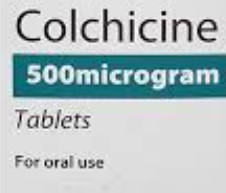
Indications and doses
- Gout.
- Psoriasis.
- Neutrophilic dermatoses (behçet disease, sweet syndrome).
- Cutaneous small vessel vasculitis.
- Neutrophil-rich autoimmune bullous diseases (EBA, linear IgA bullous dermatosis, DH, chronic bullous dermatosis of childhood).
- Aphthous stomatitis.
- Autoimmune connective tissue diseases(dermatomyositis, scleroderma (progressive systemic sclerosis),relapsing polychondritis).
- Pachydermoperiostosis
- Type ii lepra reaction.
- Anetoderma
- Actinic keratoses(topical colchicines)
- Condyloma(topical colchicines).
- Pyoderma gangrenosum.
- Severe cystic acne.
- Calcinosis cutis.
- Keloids
- Sarcoidosis.
- Fibromatosis.
- Relapsing polychondritis.
- Subcorneal pustular dermatosis.
- Erythema nodosum.
Dosage
- Starting dose of 0.5 mg/day, increasing to 0.5 mg twice or thrice daily over several weeks then taper.
- Recurrent aphthous stomatitis : 0.6 mg twice or thrice daily.
- Sweet’s syndrome :1.5 mg colchicine.
- Dermatitis herpetiformis : 1.2-1.8 mg/day.
Mechanism of action
- Anti-mitotic : Prevents microtubule assembly >> mitotic arrest at metaphase and inhibition of cellular motility.
- Anti-inflammatory: Colchicine reduces mobility, adhesiveness, and chemotaxis of polymorphonuclear cells. It interferes with intercellular adhesion molecules, selectins, thus inhibiting T-lymphocyte activation and its adhesion to endothelial cells, It impairs cellular secretion of procollagen and increases collagenase production that promotes a larger collagenolytic action.
- Immunosuppressive action :It inhibits cell-mediated immune responses, by inhibiting immunoglobulin secretion, IL-1 production, histamine release and HLA-DR expression.
Baseline Monitoring
- Full blood count.
- Renal and hepatic biochemistry.
- Urinalysis.
- Pregnancy test.
Follow Up Monitoring
- Full blood count (monthly)
- Renal and hepatic biochemistry every 3 months.
Side effects
- Watery diarrhea, vomiting, abdominal pain, bloatedness, and hyperperistalsis >> reduce the dose.
- Long-term therapy : steatorrhea, malabsorption.
- Occasionally, alopecia, peripheral neuropathy, myopathy.
- Bone marrow suppression (with prolonged therapy)>> prompt administration of G-CSF must be considered.
- Myopathy and neuropathy occur particularly in patients with renal impairment.
- Urticaria, toxic epidermal necrolysis, and precipitation of porphyria cutanea tarda.
- Multiorgan failure with acute overdose.
Contraindications
- Hypersensitivity.
- Blood dyscrasias.
- Severe renal, hepatic,gastrointestinal or cardiac disease.
Drug interactions
- Drugs that inhibit the CYP3A4 and P‐glycoprotein systems >>increase colchicine levels and toxicity:
- They include ciclosporin,erythromycin, clarithromycin, ketoconazole, itraconazole, antiviral drugs and verapamil, and grapefruit juice has a similar action.
- Co‐administration with statins may increase the risk of myopathy.
- Vitamin B12 absorption may be impaired by colchicine resulting in megaloblastic anaemia.
- Cyclosporin (cyclosporine) concentrations are increased by colchicine, with an increased risk of nephrotoxicity and neuromuscular adverse effects.
Precautions
- Colchicine must be shielded from ultraviolet light, which degrades the drug into therapeutically inactive products.
- Colchicine should be used with caution if there is renal or hepatic dysfunction.
- Colchicine should be avoided during pregnancy.
- Overdose can lead to a cholera-like syndrome with dehydration, hypokalemia, hyponatremia, metabolic acidosis, renal failure, and ultimately shock.
Pregnancy and lactation
- Colchicine should be avoided during pregnancy (formerly category C).
- Colchicine is excreted in breast milk.
- No adverse events in breastfed infants in the published literature after administration of colchicine to lactating women.
- No data available on the effects of colchicine on milk production.
Drug info
- Colchicine has been used for centuries for the treatment of acute gout.
- It is the drug of choice for treatment of familial Mediterranean fever.
- Colchicine-induced diarrhea can be controlled with aluminum-containing antacids or specific oral antidiarrheal medications, such as loperamide.
- In immunobullous dermatoses where colchicine is used, dapsone is the better choice and colchicine is an alternative where the patient cannot take dapsone due to G6PD deficiency or some other reason or dapsone is not effective in a particular patient.
- Case reports and epidemiology studies in males on colchicine therapy indicate that infertility from colchicine is rare and may be reversible.
Was this helpful?
14 / 0
#Colchicine #Colchicine indications in dermatology
Excellent information related to colchicine